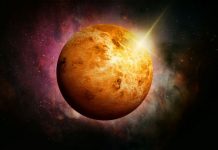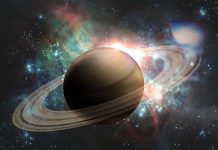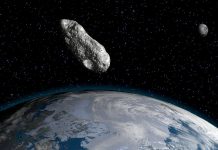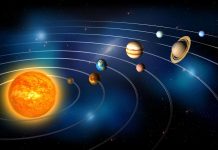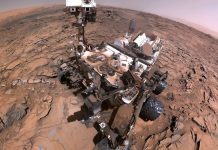It was believed life existed on Mars for much of the nineteenth century. The reason behind this belief was part mistake and part imagination. In 1877, the astronomer Giovanni Schiaparelli observed what he believed to be straight lines on Mars’ surface. As others noticed these lines, some suggested that they were too straight and could only be the work of intelligent life. The popular conclusion as to the nature of these lines was that they were canals constructed for irrigation purposes. However, with the development of more powerful telescopes in the early twentieth century, astronomers were able to view the Martian surface more clearly and determine that these straight lines were merely an optical illusion. As a result, the earlier claims of life on Mars were without evidence and, therefore, discarded.
The large amount of science fiction written during the twentieth century was a direct outgrowth of the belief that Mars possessed life. From little green men to death rays, Martians were the focus of many television and radio programs, comic books, movies, and novels.
Although the discovery of Martian life in the eighteenth century eventually proved to be false, Mars is nonetheless the planet most hospitable for life other than the Earth. As such, recent planetary missions have tried to determine if even the most basic of life exists on the planet’s surface. The Viking mission in the 1970s conducted experiments on the Martian soil in hopes of detecting microorganisms. While it was initially believed that the formation of compounds during the experiments were a result of biological agents, it has since been determined that these compounds can be created without biological mechanisms.
Even though the results lean toward the absence of life on Mars, scientists have speculated that conditions are right for life to exist beneath the planet’s surface. Future planetary missions scheduled to test the possibility of past and present life include the Mars Science Laboratory and ExoMars missions.
ATMOSPHERE
The composition of Mars’ atmosphere is extremely similar to Venus’, one of the least hospitable atmospheres in all of the Solar System. The main component in both atmospheres is carbon dioxide (95% for Mars, 97% for Venus), yet a runaway greenhouse effect has taken hold of Venus, producing temperatures in excess of 480° C, while temperatures on Mars never exceed 20° C. Thus, something other than the composition is at work. The huge difference lies in the density of the two atmospheres. Whereas Venus’ atmosphere is exceedingly thick, Mars’ is quite thin. Simply put, Mars would resemble Venus if it possessed a thicker atmosphere.
Additionally, with such a thin atmosphere, the resulting atmospheric pressure is only about 1% of that found at sea level on Earth. That is the equivalent pressure found at 35 km above the Earth’s surface.
One of the long standing areas of research regarding the Martian atmosphere is its impact on the presence of liquid water. What the research has shown is that even though the polar caps possess frozen water and the air contains water vapor—as a result of the freezing temperatures and low pressure caused by the weak atmosphere—it is not possible for liquid water to exist on the planet’s surface. However, evidence provided by planetary missions suggests liquid water does exist one meter below the planet’s surface.
Surprisingly, despite the thin atmosphere, Mars experiences weather patterns. The primary form of this weather consists of winds, with other manifestations that include dust storms, frost, and fog. As a result of this weather, some erosion has been seen to take place at particular locations on the planet’s surface.
As a final note on the Martian atmosphere, leading theories claim that it may have once been dense enough to support large oceans of water. However, through some means in the planet’s past the atmosphere was drastically altered. One popular explanation for this change is that Mars was struck by a large body and in the process a large portion of its atmosphere was ejected into space.
SURFACE
The surface of Mars can be separated into two broad features, which, coincidentally, are divided by the planet’s hemisphere. The northern hemisphere is seen to be relatively smooth with few craters, whereas the southern hemisphere is an area of highlands that are more heavily cratered than the northern plains. Other than topographical differences, the distinguishing feature of the two regions appears to be geological activity, with the northen plains being much more active.
The Martian surface is home to both the largest known volcano, Olympus Mons, and largest known canyon, Valles Marineris, in the Solar System. With a height of 25 km and a base diameter of 600 km, Olympus Mons is three times the height of Mt. Everest, the tallest mountain on the Earth. Valles Marineris is 4,000 km long, 200 km wide, and almost 7 km deep. To put the shear magnitude of its size into perspective, Valles Marineris would stretch from the East to West coast of the United States.
Perhaps the most significant discovery regarding the Martian surface was the presence of channels. What is so meaningful about these channels is that they appear to have been created by running water, and thus providing evidence to support the theory that Mars could have been much more similar to the Earth at one time.
A surface feature that has remained in popular culture since its image surfaced is the “Face on Mars.” When this photograph was captured by the Viking I spacecraft in 1976, many took it to be proof that alien life existed on Mars. However, subsequent images showed that lighting (and a little imagination) are what brought life to the formation.
INTERIOR
Similar to the other terrestrial planets, Mars’ interior is divided into three layers: a crust, mantle, and core.
Although precise measurements cannot be made, scientists can make predictions as to the thickness of the planet’s crust based on the depth of Valles Marineris. Such a deep, extensive valley system, located in the southern hemisphere, could not be present unless the crust there is significantly thicker than the Earth’s. Estimates put its thickness in the northern hemisphere at 35 km, and 80 km in the southern hemisphere.
Mercury’s core is believed to be approximately 3,000 km in diameter and composed primarily of iron. There is a significant amount of research being conducted to determine whether or not Mars’ core is solid. Some scientists point to the lack of a significant magnetic field as an indication that the core is solid. However, within the past decade much data has been gathered to indicate that the core is at least partially liquid. With the discovery of magnetized rocks on the planet’s surface, it appears, at the very least, that Mars did possess a liquid core at some point in its history.
ORBIT & ROTATION
The orbit of Mars is noteworthy for three reasons. First, its eccentricity is second largest among all the planets, smaller only than Mercury’s. As a result of this more elliptical orbit, Mars’ perihelion of 2.07 x 108 km is much larger than its aphelion of 2.49 x 108 km. Second, evidence suggests that this high degree of eccentricity has not always been present, and it may have been less than the Earth’s at some point in Mars’ history. The cause for this change is attributed to the gravitational forces exerted upon Mars by neighboring planets. Third, of all the terrestrial planets, Mars is the only one having a year that lasts longer than the Earth’s. This, of course, is due to its orbital distance. One Martian year is equal to almost 686 Earth days.
It takes Mars about 24 hours 40 minutes to complete one full rotation, easily making the Martian day the closest in length to an Earth day.
At roughly 25°, Mars’ axial tilt is yet another similarity the planet shares with Earth. What this means is Mars actually experiences seasons like those on Earth, though each is substantially longer because of the orbital distance of Mars. Unlike the Earth, however, Mars’ two hemispheres experience quite different temepratures for each season. This is due to the much larger eccentricity of the planet’s orbit.


